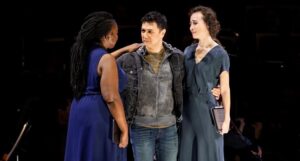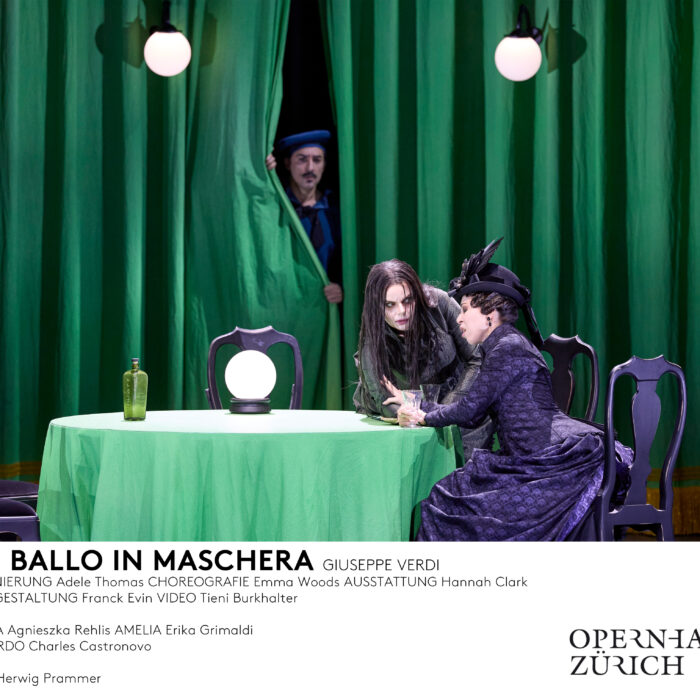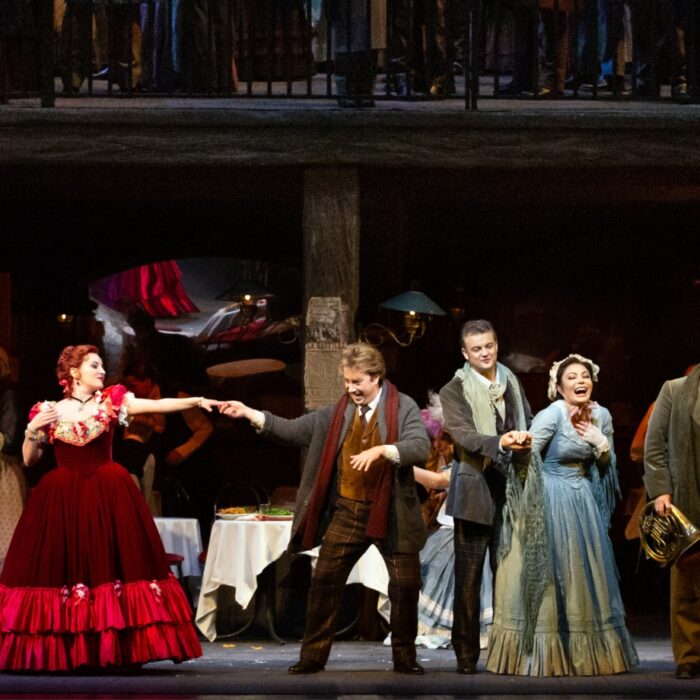
San Francisco Symphony 2022-23 Review: Adriana Mater
A Memorable Production in Honor of Kaija Saariaho
By Lois Silverstein(Credit: Credit: Brittany Hosea-Small)
Kaija Saariaho died in early June 2023. Her opera, “Adriana Mater,” opened at San Francisco Symphony a few days later. The semi-staged performance seemed like a ritual itself to honor the noted Finnish composer.
The story of human suffering in war was conducted by San Francisco’s Music Director, Esa-Pekka Salonen, with depth and finesse. Four singers and chorus sang the roles in French, and well-known Director Peter Sellars was on hand to introduce the work, in moving detail. Both Salonen and Sellars were friends and colleagues of Saariaho. It was clear to all that they brought their own personal, as well as artistic, feelings to the production. It was more than moving. The text, written by Amin Maalouf, born in Lebanon in 1949, told the story of war. Originally the Bosnian war, and violence in powerful detail, the opera also told the story of the rape of Adriana.
A Special Work
“Adriana Mater,” unfolds in two acts with seven scenes. Each scene has a particular focus and reveals a unique story. For example, Act one includes “Clartés (Light),” “Tenebres (Darkness),” and “Deus coeurs (Two Hearts).” Act two includes “Aveux (Confessions),” “Rages,” “Duel,” and “Adriana.” The overall theme underlined “the time is the present in a country about to be at war.” The plot centered on conflict between Tsargo and Adriana. The outbreak of violence between them. The outbreak of violence in the world around them, and the necessity of dealing with the child that came from Tsargo’s assault of Adriana. Additional tension emerged with the anger of Adriana’s sister, Refka, who “worries about the unborn child” and her concerns around “whether the child will resemble Cain or Abel.”
The language was metaphoric, as well as literal. It was expressive as well as informative. One of the central and most telling images being Adriana’s concern of the two hearts beating in her breast. She then went on to speak of “the fields of my heart,” and “the right to sit on my bed.” “How can you forget war if you are carrying my child?” “You are my revenge.” “The war ended for me the day you were born.” The specifics of the narrative easily transferred to other countries, and other wars. That was part of its telling effects.
The texture of the music grew out of such language coupled with a range of instruments that exquisitely articulated the story’s intense feelings and associations. There was a broad range of strings, winds and brass, with a wide range of percussion including glockenspiel and tubular bells, tom-toms, suspended cymbals, bamboo chimes, vibraphone, celesta, temple blocks, whistle, and electronics. Every instrument provided a rich palate of tone and timbre. The tolling of the bell at key intervals kept pulling listeners back to the foundation of the story, as well as carrying an overtone of Saariaho’s recent death. Although the pace was excellent, its richness in its probing narrative made it hard to fully digest all its emotional and musical plenty. Substantive subjects came fast. Emotionally it was hard to absorb them all. Still, Salonen knew this music well and made sure we heard it all, whether totally taken in or not. Surely, it called for more than even two or more hearings.
Beautiful Voices
The voices were well-blended as well as distinctive, in their own right. The four singers included Adriana, sung by mezzo extraordinaire, Fleur Barron. She is a mentee of Barbara Hannigan. The depth she sang from was a perfect locus for the sorrow and grief from which she told her part of the story. The mellow depths of her vocal sound cast a dream-like aura over her presentation. This literally conveyed her dream, as she sang the realistic details. Physically, she communicated vulnerability and self-exploration with compassion for self and others, in the first half. The legato of her voice kept us in her spell, whatever she described. At moments, she reminded me of the character Perdita from Shakespeare’s “Winter’s Tale.” She was one of the Lost, who would someday come to be redeemed.
In the second act, and during the finale, she seemed to have too much to say and convey. Scenes Six and Seven went on a bit too long. There was too much of too much, so that instead of absorption we were beset with more information and variations of it. Her resolution of hope seemed to be added on rather than discovered. Even as the text finished the tale, her smile, while appropriate, did not entirely convince.
Sister Refka, sung by Axelle Fanyo, was a strong voice and offered rich power. It served as a striking contrast to the ineffable sound of Adriana. Often rich and defiant, Fanyo aptly played out the defiance and self-declared protectiveness of her sister. Her volume broke the spell cast by Adriana’s introspective explorations. She forced us to consider the necessities of the world around them both. This strengthened the significance of the opera as a whole. Both were needed. Throughout, she remained dedicated, plangent in her plea, appropriately vindictive, fearful, and full of regret. I liked her sound and her sense.
Tsargo, sung by baritone Christopher Purves, opened with a deep, strong and mellifluous sound. It came as a surprise, when following the music and two voices, up until then. While his lines remained villainous, his seduction through protection, singing “I will come up on the roof and look for danger,” worked its magic. Who of us could resist such an offer? Especially in times of extreme danger? And yet, because we knew what he was after, we felt his anger grow and erupt. We watched judiciously. He was cagey. Yet, his voice never lost its lyricism all the while he was pressing and demanding.
Yonas, Adriana’s son, was sung by tenor Nicholas Phan. He appeared at the beginning of Act two, at age 18. His anger and frustration drove most of his action and sound. His melancholy stayed aptly in the background until the last moments of the second act when all the vulnerability of the characters came together in an energy of hope. Which was good, and touching. While it was understandable that his anger and pain dominated his presentation, it was hard to care about Yonas. Especially at the outset of Act two, he remained too focused on his problems. He offered little empathy toward his mother and then, later his aunt. So too, when it came time for his attempted murder of his father, he seemed to play a role rather than convey actual rage. Holding the gun for longer than seemed necessary, accented this point. We spent time wondering about when he was going to pull the trigger, rather than feeling a crescendo toward his intent. This too, after he “gave up.” But, why so long? What happened to his intention? Where did he “go” in that suspension? This broke the fury. Consequently, his recognition of compassion’s necessity, while sincere, felt less solid or grounded than it might be. When he sang and revealed his softer sensitivity, he was very moving.
The San Francisco Symphony Chorus was directed by guest director Jenny Wong. She added a further dimension throughout. This both amplified and accented the inner emotional lives of the characters. In the final Tableau, Scene seven, the dual repetitions of “I should have,” between the chorus and soloists, heightened the emotions of the work as well as their relationship to our own human weaknesses. However, we aim to resolve our conflicts, we often come away with a sense of lack, maybe even failure. If only. Who of us can transcend that? Particularly in struggles as massive and overwhelming as what Saariaho presented onstage?
Simple & Perfect
Since this was a semi-staged version, the simple platforms and props and were perfect. Costumes, designed by Camille Assaf, were like amped up streetwear. Lighting, created by James F. Ingalls, accented what needed to be told, the violence was red and orange, introspection and grief, were mauve and pale blue. There were bright, whiter lights for after and before. With an opera of this intensity, the simplicity of the surround was excellent. It gave us a chance to concentrate on what needed to be concentrated on and reminded us of some of the over production of many productions nowadays. How many projections do we need to watch a fully-embodied story of violence, jealousy or death? How literal must we design our opera to feel and listen to the beating heart of Otello or “Death in Venice?” A recent concert performance of “Die Walküre,” with Lise Davidson and Jonas Kaufmann, is another example of the beauteous simplicity of simple concert performance. Although we wouldn’t want to sacrifice a scene in the hut of set in “nowhere,” with a long-haired heldentenor wrapped in silverplated armor, and a dramatic soprano in her matching flowing hair, either.
Saariaho’s music was terrific. The story as described through sound was superb. Its importance was unquestionable. It enabled us to sink into its weightiness and significance. Several musical motifs reminded me of Britten’s “Peter Grimes,” with the haunting sounds of loss and suspension of human connection, particular when Grimes was suspended between the human and the suspected. This fundamental need for human connection and its rupture through force. This inevitable shrinking of our emotional range and our isolation, as a result were shown and alluded to in Saariaho’s work as it is in so much of “Grimes” and other Britten works. I remain a fan.
Saariaho’s offering kept us there. It was fitting to honor and thank her with the extraordinary power of her work.


